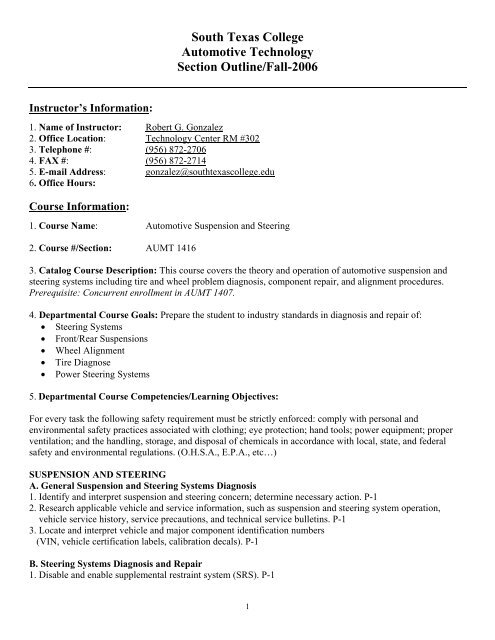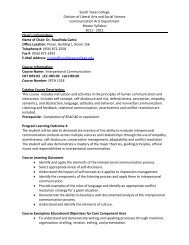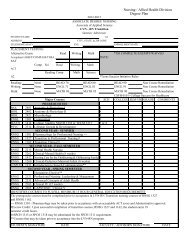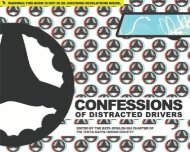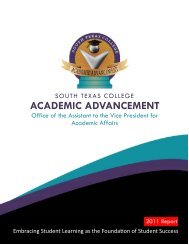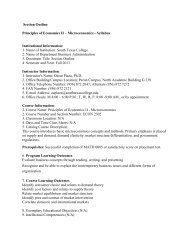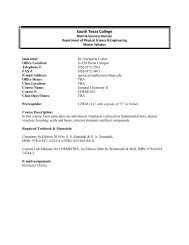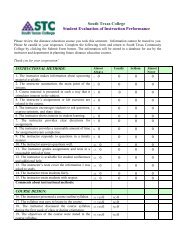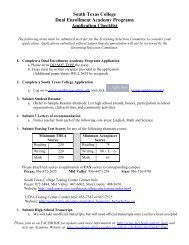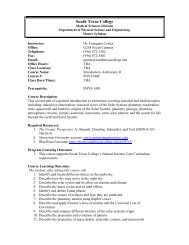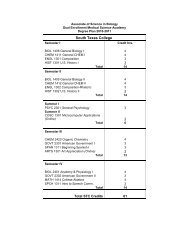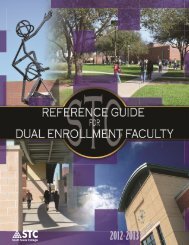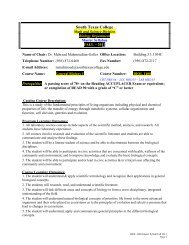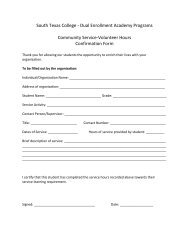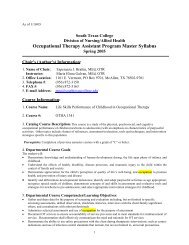South Texas College Automotive Technology Section Outline/Fall ...
South Texas College Automotive Technology Section Outline/Fall ...
South Texas College Automotive Technology Section Outline/Fall ...
You also want an ePaper? Increase the reach of your titles
YUMPU automatically turns print PDFs into web optimized ePapers that Google loves.
<strong>South</strong> <strong>Texas</strong> <strong>College</strong><br />
<strong>Automotive</strong> <strong>Technology</strong><br />
<strong>Section</strong> <strong>Outline</strong>/<strong>Fall</strong>-2006<br />
Instructor’s Information:<br />
1. Name of Instructor: Robert G. Gonzalez<br />
2. Office Location: <strong>Technology</strong> Center RM #302<br />
3. Telephone #: (956) 872-2706<br />
4. FAX #: (956) 872-2714<br />
5. E-mail Address: gonzalez@southtexascollege.edu<br />
6. Office Hours:<br />
Course Information:<br />
1. Course Name: <strong>Automotive</strong> Suspension and Steering<br />
2. Course #/<strong>Section</strong>: AUMT 1416<br />
3. Catalog Course Description: This course covers the theory and operation of automotive suspension and<br />
steering systems including tire and wheel problem diagnosis, component repair, and alignment procedures.<br />
Prerequisite: Concurrent enrollment in AUMT 1407.<br />
4. Departmental Course Goals: Prepare the student to industry standards in diagnosis and repair of:<br />
• Steering Systems<br />
• Front/Rear Suspensions<br />
• Wheel Alignment<br />
• Tire Diagnose<br />
• Power Steering Systems<br />
5. Departmental Course Competencies/Learning Objectives:<br />
For every task the following safety requirement must be strictly enforced: comply with personal and<br />
environmental safety practices associated with clothing; eye protection; hand tools; power equipment; proper<br />
ventilation; and the handling, storage, and disposal of chemicals in accordance with local, state, and federal<br />
safety and environmental regulations. (O.H.S.A., E.P.A., etc…)<br />
SUSPENSION AND STEERING<br />
A. General Suspension and Steering Systems Diagnosis<br />
1. Identify and interpret suspension and steering concern; determine necessary action. P-1<br />
2. Research applicable vehicle and service information, such as suspension and steering system operation,<br />
vehicle service history, service precautions, and technical service bulletins. P-1<br />
3. Locate and interpret vehicle and major component identification numbers<br />
(VIN, vehicle certification labels, calibration decals). P-1<br />
B. Steering Systems Diagnosis and Repair<br />
1. Disable and enable supplemental restraint system (SRS). P-1<br />
1
2. Remove and replace steering wheel; center/time supplemental restraint system (SRS) coil (clock spring). P-1<br />
3. Diagnose steering column noises, looseness, and binding concerns (including tilt mechanisms); determine<br />
necessary action. P-2<br />
4. Diagnose power steering gear (non-rack and pinion) binding, uneven turning effort, looseness, hard steering,<br />
and fluid leakage concerns; determine necessary action. P-3<br />
5. Diagnose power steering gear (rack and pinion) binding, uneven turning effort, looseness, hard steering, and<br />
fluid leakage concerns; determine necessary action. P-3<br />
6. Inspect steering shaft universal-joint(s), flexible coupling(s), collapsible column, lock cylinder mechanism,<br />
and steering wheel; perform necessary action. P-2<br />
7. Adjust manual or power non-rack and pinion worm bearing preload and sector lash. P-3<br />
8. Remove and replace manual or power rack and pinion steering gear;<br />
inspect mounting bushings and brackets. P-1<br />
9. Inspect and replace manual or power rack and pinion steering gear inner tie rod ends (sockets)<br />
and bellows boots. P-1<br />
10. Inspect power steering fluid levels and condition. P-1<br />
11. Flush, fill, and bleed power steering system. P-2<br />
12. Diagnose power steering fluid leakage; determine necessary action. P-2<br />
13. Remove, inspect, replace, and adjust power steering pump belt. P-1<br />
14. Remove and reinstall power steering pump. P-3<br />
15. Remove and reinstall power steering pump pulley; check pulley and belt alignment. P-3<br />
16. Inspect and replace power steering hoses and fittings. P-2<br />
17. Inspect and replace pitman arm, relay (centerlink/intermediate) rod, idler arm and mountings,<br />
and steering linkage damper. P-2<br />
18. Inspect, replace, and adjust tie rod ends (sockets), tie rod sleeves, and clamps. P-1<br />
19. Test and diagnose components of electronically controlled steering systems using a scan tool; determine<br />
necessary action. P-3<br />
C. Suspension Systems Diagnosis and Repair<br />
1. Front Suspension<br />
1. Diagnose short and long arm suspension system noises, body sway, and uneven riding height concerns;<br />
determine necessary action. P-1<br />
2. Diagnose strut suspension system noises, body sway, and uneven riding height concerns;<br />
determine necessary action. P-1<br />
3. Remove, inspect, and install upper and lower control arms, bushings, shafts, and rebound bumpers. P-3<br />
4. Remove, inspect and install strut rods (compression/tension) and bushings. P-2<br />
5. Remove, inspect, and install upper and/or lower ball joints. P-2<br />
6. Remove, inspect, and install steering knuckle assemblies. P-2<br />
7. Remove, inspect, and install short and long arm suspension system coil springs and spring insulators. P-2<br />
8. Remove, inspect, install, and adjust suspension system torsion bars; inspect mounts. P-3<br />
9. Remove, inspect, and install stabilizer bar bushings, brackets, and links. P-2<br />
10. Remove, inspect, and install strut cartridge or assembly, strut coil spring, insulators (silencers), and upper<br />
strut bearing mount. P-1<br />
11. Lubricate suspension and steering systems. P-2<br />
2. Rear Suspension<br />
1. Remove, inspect, and install coil springs and spring insulators. P-2<br />
2. Remove, inspect, and install transverse links, control arms, bushings, and mounts. P-2<br />
3. Remove, inspect, and install leaf springs, leaf spring insulators (silencers), shackles, brackets,<br />
2
ushings, and mounts. P-3<br />
4. Remove, inspect, and install strut cartridge or assembly, strut coil spring, and insulators (silencers). P-2<br />
3. Miscellaneous Service<br />
1. Inspect, remove, and replace shock absorbers. P-1<br />
2. Remove, inspect, and service or replace front and rear wheel bearings. P-1<br />
3. Test and diagnose components of electronically controlled suspension systems using a scan tool; determine<br />
necessary action. P-3<br />
D. Wheel Alignment Diagnosis, Adjustment, and Repair<br />
1. Differentiate between steering and suspension concerns using principles of steering geometry<br />
(caster, camber, toe, etc). P-1<br />
2. Diagnose vehicle wander, drift, pull, hard steering, bump steer, memory steer, torque steer, and steering<br />
return concerns; determine necessary action. P-1<br />
3. Perform prealignment inspection; perform necessary action. P-1<br />
4. Measure vehicle riding height; determine necessary action. P-1<br />
5. Check and adjust front and rear wheel camber; perform necessary action. P-1<br />
6. Check and adjust caster; perform necessary action. P-1<br />
7. Check and adjust front wheel toe; adjust as needed. P-1<br />
8. Center steering wheel. P-1<br />
9. Check toe-out-on-turns (turning radius); determine necessary action. P-2<br />
10. Check SAI (steering axis inclination) and included angle; determine necessary action. P-2<br />
11. Check and adjust rear wheel toe. P-2<br />
12. Check rear wheel thrust angle; determine necessary action. P-2<br />
13. Check for front wheel setback; determine necessary action. P-2<br />
14. Check front cradle (subframe) alignment; determine necessary action. P-3<br />
E. Wheel and Tire Diagnosis and Repair<br />
1. Diagnose tire wear patterns; determine necessary action. P-1<br />
2. Inspect tires; check and adjust air pressure. P-1<br />
3. Diagnose wheel/tire vibration, shimmy, and noise; determine necessary action. P-2<br />
4. Rotate tires according to manufacturer’s recommendations. P-1<br />
5. Measure wheel, tire, axle, and hub runout; determine necessary action. P-2<br />
6. Diagnose tire pull (lead) problem; determine necessary action. P-2<br />
7. Balance wheel and tire assembly (static and dynamic). P-1<br />
8. Dismount, inspect, repair, and remount tire on wheel. P-2<br />
9. Reinstall wheel; torque lug nuts. P-1<br />
10. Inspect and repair tire. P-2<br />
6. Departmental Course Requirements, Evaluation Methods, and Grading Criteria:<br />
A= 100-90 50% Lab<br />
B= 89-80 30% Theory<br />
C= 79-70 20% Final Exam<br />
F= 69-0<br />
7. Required Textbook & Resources:<br />
-Title: <strong>Automotive</strong> Suspension & Steering Systems (3 rd Edition)<br />
- Publisher: Thomson Learning/Del Mar<br />
- Author: Don Knowles<br />
-ISBN: 0-7668-5998-3<br />
3
-Tools:<br />
<strong>Automotive</strong> Tool Kit (see student tool list)<br />
SCANS Information:<br />
1. Departmental Foundation Skills:<br />
1. Basic Skills:<br />
Reading<br />
Writing<br />
Mathematics<br />
Arithmetic<br />
Speaking<br />
Listening<br />
2. Thinking Skills:<br />
Seeing things in the mind’s eye<br />
Knowing how to learn<br />
Reasoning<br />
3. Personal Qualities:<br />
Responsibility<br />
Sociability<br />
Self-Management<br />
Integrity/honesty<br />
The student will read text, shop manuals and<br />
automotive references<br />
The student will complete written repair orders, or<br />
assignments as required by instructor.<br />
The student will use mathematics to solve or<br />
determine specifications, according to<br />
manufacturer’s specifications.<br />
The student will present an oral presentation.<br />
The student will analyze/diagnose and identify<br />
malfunctions according to manufacturer’s<br />
specifications.<br />
The student will appropriately estimate cost of<br />
repairs<br />
All students are required to dress accordingly.<br />
All students are required to conduct themselves in<br />
a courteous and ethical manner, with customers<br />
and co-workers.<br />
All students are responsible to purchase their own<br />
hand tools, (see student <strong>Automotive</strong> tool list), and<br />
must be kept clean and in good, operating<br />
conditions.<br />
All students are required to respect other students’<br />
personal items/property, such as tools, books, etc.<br />
All students are encouraged to used fender covers,<br />
and demonstrate cleanness while working on<br />
customer vehicles and to develop professional<br />
work ethics.<br />
2. Departmental Workplace Competencies: (for Technical Courses)<br />
1. Resources:<br />
Time, money, materials and facilities,<br />
human resources<br />
2. Interpersonal:<br />
Participate as a member of a team<br />
Teaches other new skills<br />
Exercises Leadership<br />
Works with diversity<br />
3. Information:<br />
Acquires and evaluates information<br />
Organizes and maintains information<br />
Interprets and communicates information<br />
4
Uses computers to process information<br />
4. Systems:<br />
Understanding systems<br />
The student will be able to troubleshoot/diagnose,<br />
through class lectures, lab sessions and reading<br />
texts, and shop manuals to meet manufacturer's<br />
specifications.<br />
5. <strong>Technology</strong>:<br />
Works with a variety of technologies<br />
The student will use different types of testing<br />
equipment to diagnose malfunctions<br />
6. Information:<br />
Acquires and evaluates information<br />
Organizes and maintains information<br />
Interprets and communicates information<br />
The student will utilize computerized data<br />
information for proper repair procedures,<br />
according to manufacturer's specifications.<br />
ADA Students with Disabilities Statement: Reasonable accommodations may be made that allow<br />
disabled students to be successful at STC. Accommodations may be provided for those students who submit the<br />
appropriate documentation by an outside/independent professional evaluator or agency. Contact an STC<br />
ADA/DSS Counselor in the Annex (Pecan) or call (956) 688-2006. Students may volunteer to inform the<br />
Instructor about their disability and associated classroom limitations, if applicable.<br />
5


